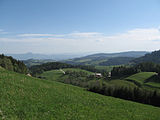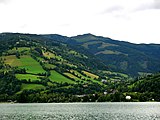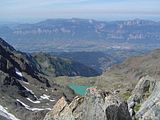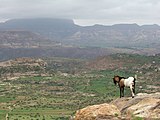Low mountain character
Upland character and mittelgebirgig are blurred landscape geographical expressions to comparatively lower mountain chains of a high mountain to mark whose appearance -, rounded peaks missing rock walls, battlements or ridges, closed plant cover (despite optionally alpine heights ) - rather to Mountain remember.
On the concept of the low mountain range
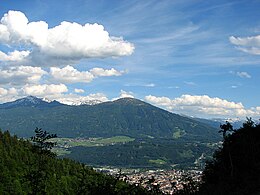
In front of the valley floor, above the typical valley shoulder of the " low mountain range " (settlement area up to approx. 1000 m). Behind the mountains of the Tuxer Voralpen (forest and alpine region). In the distance the first peaks of the “real” Alps ( Tux Alps , now part of the Zillertal Alps ).
Central Mountains is called today - primarily from the German geography starting - a mountain or range of hills of low elevation above the surrounding area with a relief energy between at least 200/500 m m to more than 1000th Deviating from this, in high mountain geography - especially in the Austrian alpine tradition - one speaks of medium-mountainous in foothills as well as mountain groups and mountains within the mountain ranges, which in the heights clearly lag behind the main chains.
Like the name of the foothills of the Alps , the expression comes from the Alpine region itself. In Tyrol, for example, low mountain ranges are those settlement areas that are not a valley floor, but also not yet a real mountain area: They are particularly special in the Inn and Etsch valleys as glacial terraces ( valley shoulder ) pronounced and important settlement area. The foothills of the Alps rise above this , which is not a peripheral location of the Alps (foothills), but an altitude level in front of the actual high mountains . Thus low mountain ranges first entered the technical language of alpine studies (18th / 19th century). Therefore, the Alps are also referred to as low mountain ranges in those mountain areas that are neither high nor rugged enough for a high alpine appearance, i.e. are rather gentle and green right up to the summit .
In Central Europe, the border to the high mountains is around 1500 to 1800 m and corresponds to the border between the montane and alpine altitudes , whereby subalpine describes the transition form ( ecotone ) of the " Krummholzzone ": Submontane is still ecumenical , i.e. permanent settlement area , the montane-alpine transition zone only habitable in summer ( sub-ecumenism , alpine pasture region ), and high alpine the upper limit of any cultivation ( anecumens ). The coming of the early Tyrolean mountaineering concept of "medium" -gebirgigen ensures - in German-speaking and non-alpine mountain research - to this day for some confusion, it is called submontan (up to 1000 m) in the earlier literature often "low mountain stage," montane (up to 1500–1800 m) but “intermediate level”, but also “low mountain range” explicitly for alpine locations. The technical terms formed from Latin are more clearly defined.
Therefore - in the technical jargon of geomorphology - low mountain landscape is largely synonymous with mountain country excluding high mountains (low mountain character can also have the summit of a high country ), low mountain range or low mountain zone in ecological geosciences, but primarily an indication of height.
- Low mountain landscapes of the Alps
The low mountain range in the Burgrave Office of South Tyrol, around Dorf Tirol
The edge-alpine pre-Alps with low mountain range character and alpine summit corridor ( Höllengebirge , Upper Austria)
Eastern foothills of the Alps as a moderate hill country ( Bacher Mountains )
Characteristic low mountain range of the central Alps ( Niedere Tauern , section of the main Alpine ridge )
Slate Alps , the largest inner-alpine low mountain range ( Tyrol / Kitzbühel and Salzburg slate Alps , grass mountains customary in the area )
The pronounced forest quality is no longer characteristic of the low mountain range of the Southern Alps ( Croix de Belledonne )
- Low mountain ranges worldwide
The Dinarides are only high mountain in core areas
Apennines (Gran Sasso massif 2912 m, but largely a low mountain range)
Highlands of Abyssinia (despite heights of 2000 to 4533 m consistently low mountain range)
Individual evidence
- ↑ Andreas Heitkamp: More than just the height, The attempt at a typology , chapter in the mountain formation dossier on scinexx.de, November 26, 2004, accessed on June 17, 2020.
- ↑ For use in this sense, see W. Kilian, F. Müller, F. Starlinger: Wuchsgebiete Austria. A natural area structure according to forest ecological aspects. Federal Forest Research Institute 1993, ISSN 0374-9037 . In Switzerland, the term “low mountain range” is rarely used because the central plateau represents the plain between the Alps and the Jura; Mittelalpen is an older word for Central Alps , so it also designates a section in the extension, not the height stratification.
- ↑ Meyers 1905: "Low mountain range from 1600-2250 m altitude". Mountains . In: Meyers Großes Konversations-Lexikon . 6th edition. Volume 7, Bibliographisches Institut, Leipzig / Vienna 1907, p. 408 . - Column 2.
Remarks
- ↑ The information varies depending on the region and its overall profile
- ↑ Another term that is also misleading: Swiss Prealps and Eastern Austrian ( Lower Austrian Prealps , Upper Austrian Prealps , the trains upstream of the Kalkhochalpen ) denote the edge of the Alps , while in Tyrol it is an inner-Alpine area. The local term in the first sense was introduced by the Prussian Johann Gottfried Ebel in 1808 in general alpine research.
- ↑ The name Alps (sic) for the altitude level above about 2000 m (subalpine and above, i.e. today's concept of high mountains), in contrast to a lowermost wooded part , was coined by the Swiss Johann Georg Sulzer in 1745.
- ↑ See Altitude Level (Ecology) for a detailed discussion


